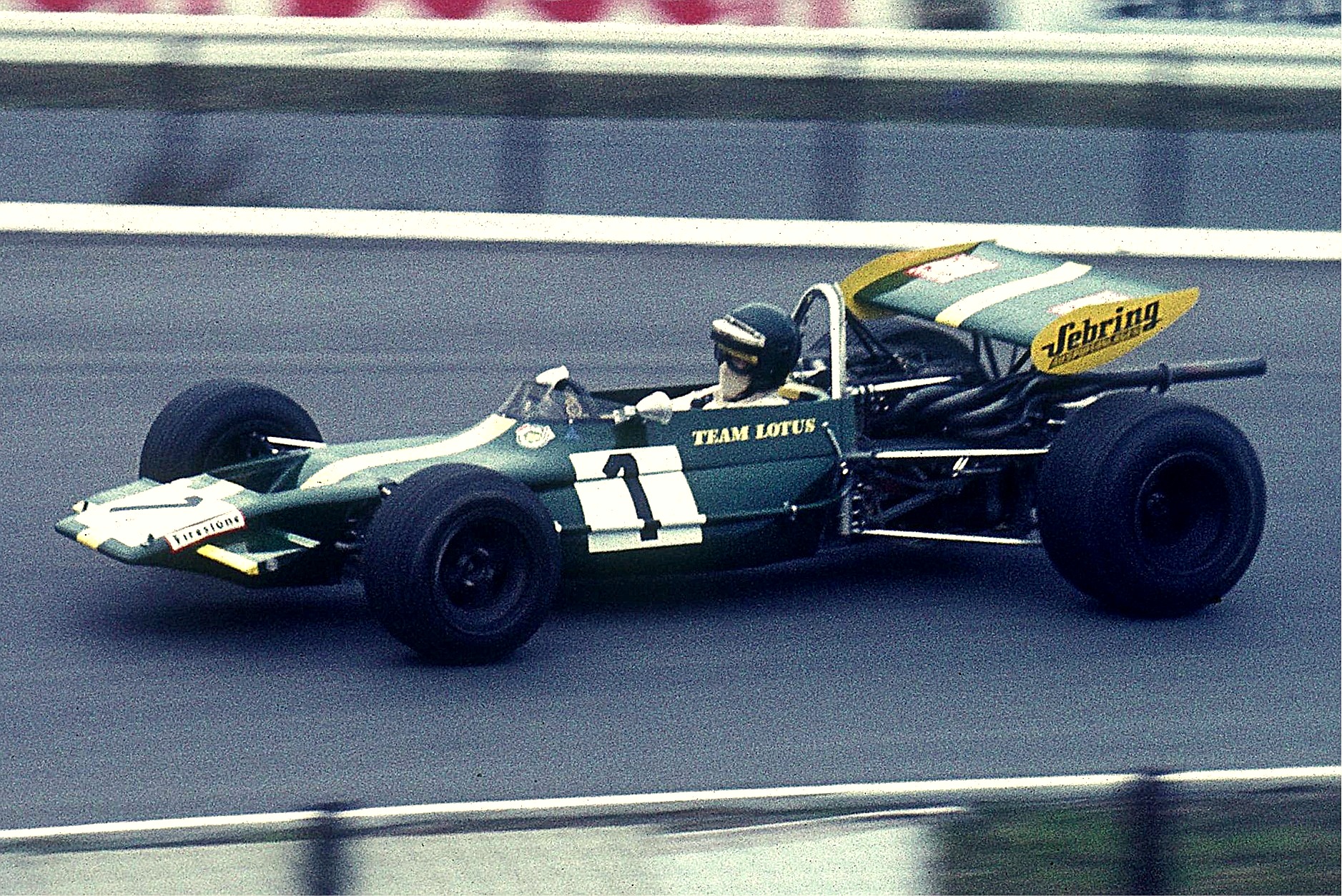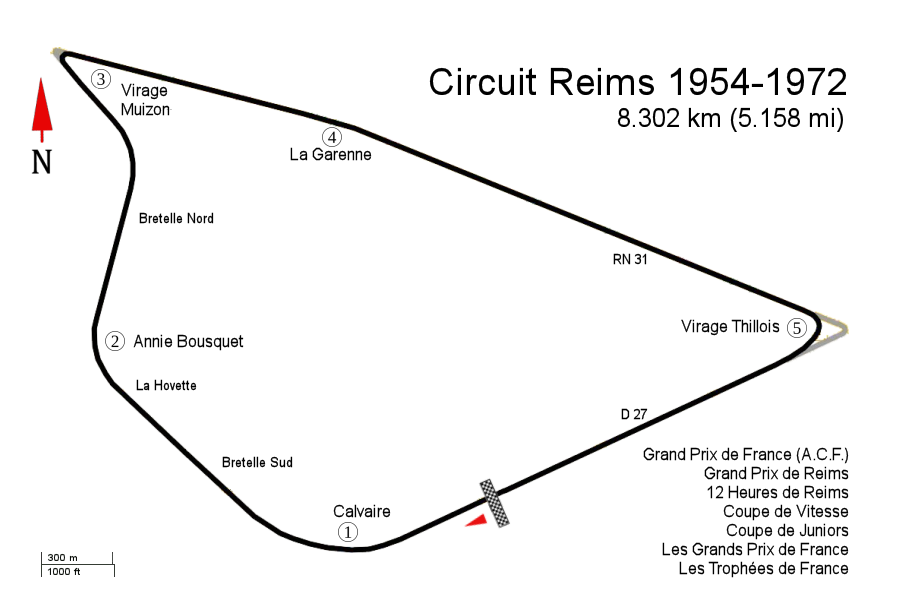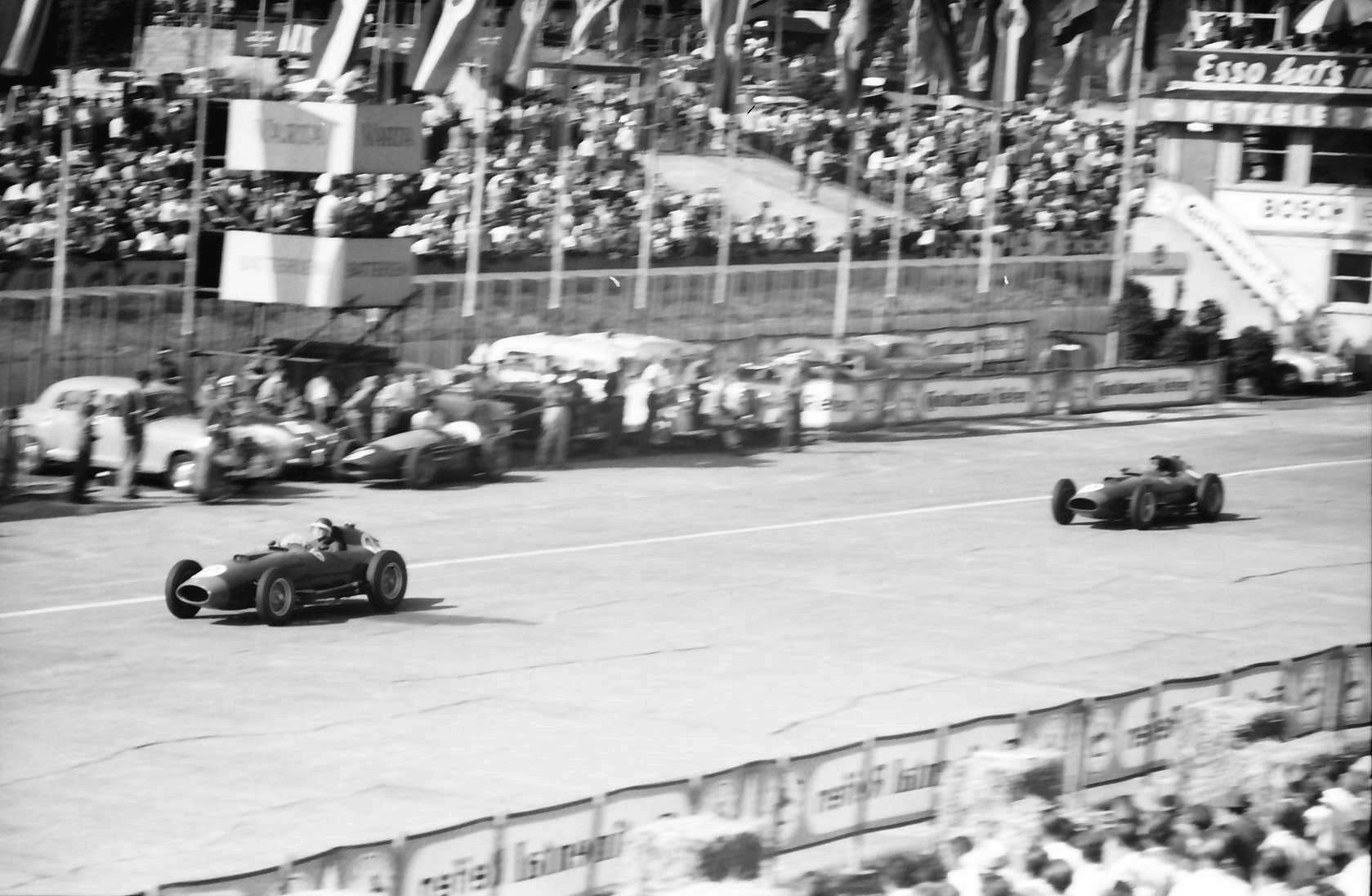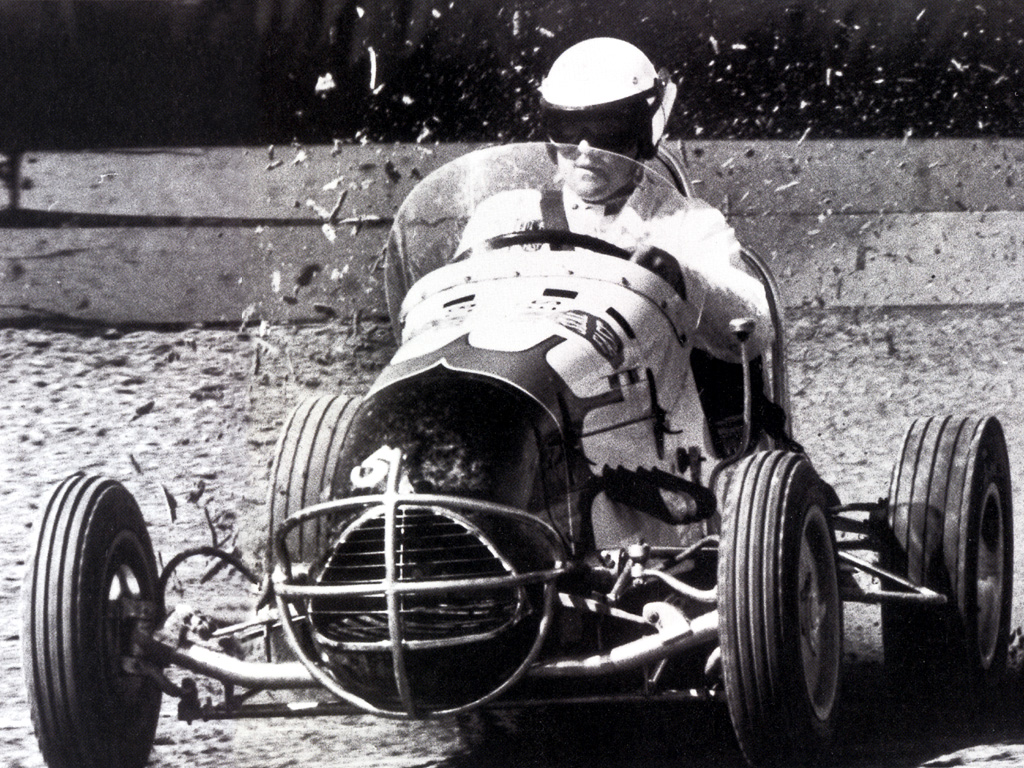|
Tony Brooks (racing Driver)
Charles Anthony Standish Brooks (25 February 1932 – 3 May 2022) was a British racing driver also known as the "Racing Dentist". He participated in 39 Formula One World Championship Grands Prix, competing for the first time on 14 July 1956, and achieved six wins, 10 podium finishes and 75 career points. He was third in the World Drivers' Championship in with Vanwall and second in with Ferrari. He also scored the first win by a British driver in a British car in a Grand Prix since 1923, driving a Connaught at Syracuse in 1955 in a non-championship race. After the death of Sir Stirling Moss in 2020 and before his own death in 2022, Brooks was the last surviving Grand Prix winner from the 1950s. Career Brooks was born on 25 February 1932, in Dukinfield, Cheshire, and educated at Mount St Mary's College. He was the son of a dental surgeon, Charles Standish Brooks, and studied the practice himself. He was also a cousin of Norman Standish Brooks, a former British Olympic swimmer ... [...More Info...] [...Related Items...] OR: [Wikipedia] [Google] [Baidu] |
Dukinfield
Dukinfield is a town in Tameside, Greater Manchester, England, on the south bank of the River Tame opposite Ashton-under-Lyne, east of Manchester. At the 2011 Census, it had a population of 19,306. Within the boundaries of the historic county of Cheshire, the town developed as a result of the Industrial Revolution when it became the site of coal mining and cotton manufacturing. History Early history The earliest evidence of human activity around Dukinfield comes from a collection of four flints from the late Neolithic/early Bronze Age. The artifacts were discovered on the site of Dukinfield Hall and have been taken as evidence of a prehistoric settlement on the site. There is no further evidence of activity in the area until the Roman period. A 3rd century bronze Roman coin, from the reign of Emperor Tetricus I was discovered in the town. Dukinfield means "Raven of the Field" and derives from the Old English ''duce'' and ''feld''. Early records show the township was inc ... [...More Info...] [...Related Items...] OR: [Wikipedia] [Google] [Baidu] |
Formula Two
Formula Two (F2 or Formula 2) is a type of open-wheel formula racing category first codified in 1948. It was replaced in 1985 by Formula 3000, but revived by the FIA from 2009–2012 in the form of the FIA Formula Two Championship. The name returned in 2017 when the former GP2 Series became known as the FIA Formula 2 Championship. History While Formula One has generally been regarded as the pinnacle of open-wheeled auto racing, the high-performance nature of the cars and the expense involved in the series has always meant a need for a path to reach this peak. For much of the history of Formula One, Formula Two has represented the penultimate step on the motorsport ladder. Pre-war Prior to the Second World War, there usually existed a division of racing for cars smaller and less powerful than Grand Prix racers. This category was usually called voiturette ("small car") racing and provided a means for amateur or less experienced drivers and smaller marques to prove themselves. ... [...More Info...] [...Related Items...] OR: [Wikipedia] [Google] [Baidu] |
AVUS
The Automobil-Verkehrs- und Übungsstraße ('Automobile traffic and training road'), known as AVUS, is a public road in Berlin, Germany. Opened in 1921, it was also used as a motor racing circuit until 1998. Today, the AVUS forms the northern part of the Bundesautobahn 115. Circuit The highway is located in the southwestern districts of Berlin, linking the Stadtring at the Funkturm junction in Charlottenburg with Nikolassee. It runs through the Grunewald forest along the historic ''Königsweg'' road from Charlottenburg to Potsdam and the parallel Berlin-Blankenheim railway line. While normal for a road, it is unusually shaped for a race track as it is essentially two long straights in the form of a dual carriageway, with a hairpin corner at each end. The north curve featured a steep banking from 1937 to 1967. While the original layout was long, the southern turn was moved several times, to shorten the track to , then without the banking, and finally . History In 1907 the K ... [...More Info...] [...Related Items...] OR: [Wikipedia] [Google] [Baidu] |
1959 British Grand Prix
The 1959 British Grand Prix was a Formula One motor race held at the Aintree Circuit on 18 July 1959. It was race 5 of 9 in the 1959 World Championship of Drivers and race 4 of 8 in the 1959 International Cup for Formula One Manufacturers. It was the 14th British Grand Prix and the third to be held at the Aintree Motor Racing Circuit, a circuit mapped out in the grounds of the Aintree Racecourse horse racing venue. The race was held over 75 laps of the four kilometre circuit for a race distance of 362 kilometres. The race was won by Australian Jack Brabham taking his second Grand Prix victory in a works Cooper T51. Brabham dominated the race, leading all 75 laps to win by 22 seconds over British driver Stirling Moss driving a British Racing Partnership entered BRM P25. It was the first time a BRP entry finished in the top three. Brabham's Cooper Car Company teammate, New Zealander Bruce McLaren finished in third place, just 0.2 seconds behind Moss, having lost second place la ... [...More Info...] [...Related Items...] OR: [Wikipedia] [Google] [Baidu] |
Reims-Gueux
The circuit Reims-Gueux was a Grand Prix motor racing road course, located in Gueux, Marne, Gueux, 7.5 km (5 miles) west of Reims in the Champagne (historical province), Champagne region of north-eastern France, established in 1926 as the second venue of the Grand Prix de la Marne. The triangular layout of public roads formed three sectors between the villages of Thillois and Gueux, Marne, Gueux over the La Garenne-Colombes, La Garenne / Gueux intersection of Route nationale 31. The circuit became known to be among the fastest of the era for its two long straights (approximately 2.2 km; 1¼ miles in length each) allowing maximum straight-line speed, resulting in many famous slipstream battles. Circuit history Motor racing at Reims started in 1926 with the second Grand Prix de la Marne, relocating the race from the square-shaped Circuit de Beine-Nauroy east of Reims to Reims-Gueux, west of Reims. The original circuit placed the start/finish line on road D27, approxima ... [...More Info...] [...Related Items...] OR: [Wikipedia] [Google] [Baidu] |
1959 French Grand Prix
The 1959 French Grand Prix was a Formula One motor race held at Reims on 5 July 1959. It was race 4 of 9 in the 1959 World Championship of Drivers and race 3 of 8 in the 1959 International Cup for Formula One Manufacturers. It was the 37th French Grand Prix and the twelfth to be held at the Reims highway circuit and the fourth to be held on the longer and faster 8.348 km layout. The race was held over 50 laps of the eight kilometre circuit for a race distance of 417 kilometres. The race was won by British driver Tony Brooks driving a Ferrari 246 F1. Brooks dominated the race, leading all 50 laps and winning by 27 seconds over his American Scuderia Ferrari teammate Phil Hill. Brooks said after the race a sticking throttle in the closing laps made it more difficult than the result seemed. Australian driver Jack Brabham was over a minute behind in third position driving a Cooper T51 for the factory Cooper racing team after stopping to get new goggles as the circuit broke up. R ... [...More Info...] [...Related Items...] OR: [Wikipedia] [Google] [Baidu] |
1959 Dutch Grand Prix
The 1959 Dutch Grand Prix was a Formula One motor race held at Zandvoort on 31 May 1959. It was the ninth Dutch Grand Prix. The race was held over 75 laps of the four kilometre circuit for a race distance of 314 kilometres. It was race 3 of 9 in the 1959 World Championship of Drivers and race 2 of 8 in the 1959 International Cup for Formula One Manufacturers. The race was won by Swedish driver Joakim Bonnier driving a BRM P25. It would be the only World Championship victory of Bonnier's fifteen-year Grand Prix career. It was also the first win for the Owen Racing Organisation, the race team of the constructor BRM, after almost a decade of effort. Bonnier won by fifteen seconds over Australian driver Jack Brabham driving a Cooper T51, to become the first Swedish driver to win a Formula One Grand Prix. Brabham's American teammate Masten Gregory was the only other driver to finish on the lead lap in his Cooper T51 in third position. Brabham's second position expanded his championsh ... [...More Info...] [...Related Items...] OR: [Wikipedia] [Google] [Baidu] |
1959 Monaco Grand Prix
The 1959 Monaco Grand Prix was a Formula One motor race held at the Circuit de Monaco on 10 May 1959. It was race 1 of 9 in the 1959 World Championship of Drivers and race 1 of 8 in the 1959 International Cup for Formula One Manufacturers. It was also the 17th Monaco Grand Prix. The race was held over 100 laps of the three kilometre circuit for a race distance of 315 kilometres. The race was won by Australian racer Jack Brabham driving a Cooper T51 for the factory Cooper Car Company team. It was the first win for Brabham, a future three-time world champion. It was the first World Championship Grand Prix victory by an Australian driver. It was also the first win for the factory Cooper team. Coopers had won races previously in the hands of Rob Walker Racing Team. Brabham finished 20 seconds ahead of British driver Tony Brooks driving a Ferrari 246. A lap down in third was the Cooper T51 of French driver and 1958 Monaco Grand Prix winner Maurice Trintignant of the Rob Walker Rac ... [...More Info...] [...Related Items...] OR: [Wikipedia] [Google] [Baidu] |
Peter Collins (racing Driver)
Peter John Collins (6 November 1931 – 3 August 1958) was a British racing driver. He was killed in the 1958 German Grand Prix, just weeks after winning the RAC British Grand Prix. He started his career as a 17-year-old in 1949, impressing in Formula 3 races, finishing third in the 1951 Autosport National Formula 3 Championship. Early life and racing career Born on 6 November 1931, Collins grew up in Mustow Green, Kidderminster, Worcestershire, England. The son of a motor-garage owner and haulage merchant, Collins became interested in motor vehicles at a young age. He was expelled from school at 16 owing to spending time at a local fairground during school hours. He became an apprentice in his father's garage and began competing in local trials races. In common with many British drivers of the time, Collins began racing in the 500 cc category (adopted as Formula 3 at the end of 1950), when his parents bought him a Cooper 500 from the fledgling Cooper Car Company. Succ ... [...More Info...] [...Related Items...] OR: [Wikipedia] [Google] [Baidu] |
Mike Hawthorn
John Michael Hawthorn (10 April 1929 – 22 January 1959) was a British racing driver. He became the United Kingdom's first Formula One World Champion driver in 1958, whereupon he announced his retirement, having been profoundly affected by the death of his teammate and friend Peter Collins two months earlier in the 1958 German Grand Prix. Hawthorn also won the 1955 24 Hours of Le Mans, but was haunted by his involvement in the disastrous crash that marred the race. Hawthorn died in a road accident three months after retiring. With a total of three career World Championship Grand Prix wins Hawthorn has the lowest number of Grand Prix wins scored by any Formula One World Champion. Early life Mike Hawthorn was born in Mexborough, West Riding of Yorkshire, England, to Leslie and Winifred (née Symonds) Hawthorn, and educated at Ardingly College, West Sussex, followed by studies at Chelsea technical college and an apprenticeship with a commercial vehicle manufacturer. His fathe ... [...More Info...] [...Related Items...] OR: [Wikipedia] [Google] [Baidu] |
Jack Brabham
Sir John Arthur Brabham (2 April 1926 – 19 May 2014) was an Australian racing driver who was Formula One World Champion in , , and . He was a founder of the Brabham racing team and race car constructor that bore his name. Brabham was a Royal Australian Air Force flight mechanic and ran a small engineering workshop before he started racing midget cars in 1948. His successes with midgets in Australian and New Zealand road racing events led to his going to Britain to further his racing career. There he became part of the Cooper Car Company's racing team, building as well as racing cars. He contributed to the design of the mid-engined cars that Cooper introduced to Formula One and the Indianapolis 500, and won the Formula One world championship in 1959 and 1960. In 1962 he established his own Brabham marque with fellow Australian Ron Tauranac, which in the 1960s became the largest manufacturer of customer racing cars in the world. In the 1966 Formula One season Brabham be ... [...More Info...] [...Related Items...] OR: [Wikipedia] [Google] [Baidu] |
Vanwall VW5 Aintree 1957
Vanwall was a motor racing team and racing car constructor that was active in Formula One during the 1950s. Founded by Tony Vandervell, the Vanwall name was derived by combining the name of the team owner with that of his Thinwall bearings produced at the Vandervell Products factory at Acton, London. Originally entering modified Ferraris in non-championship races, Vanwall constructed their first cars to race in the 1954 Formula One season. The team achieved their first race win in the 1957 British Grand Prix, with Stirling Moss and Tony Brooks sharing a VW 5, earning the team the distinction of constructing the first British-built car to win a World Championship race. Vanwall won the inaugural Constructors' Championship in Formula One in , in the process allowing Moss and Brooks to finish second and third in the Drivers' Championship standings, winning three races each. Vandervell's failing health meant 1958 would be the last full season; the squad ran cars in a handful of r ... [...More Info...] [...Related Items...] OR: [Wikipedia] [Google] [Baidu] |







